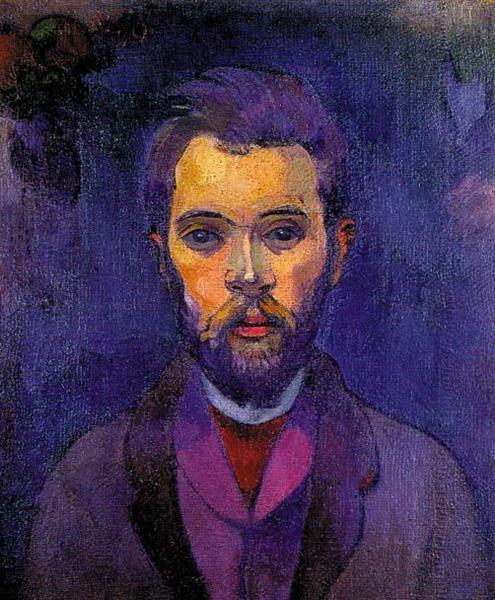Opis
Paul Gauguin's "Portrait of William Molard" (1894) is a fascinating example of the artist's distinctive style, which combines impressionism with more expressionist and symbolic elements. In this portrait, Gauguin captures not only the appearance of his friend and artistic accomplice, but also a wandering evocation of the character and essence of the individual, turning the canvas into a vehicle for emotional introspection.
The composition of the painting is notable for its simplicity and direct focus on the sitter. William Molard appears in the centre of the work, providing a strong visual anchor that guides the viewer's gaze. His slightly bent posture and the direction of his gaze give a sense of introspection, almost as if he were lost in thought. The choice of a dark background, which blends with his attire, highlights the figure of the sitter, giving it a monumentality that invokes a sense of solemnity.
Gauguin uses a rich but restrained colour palette. Dark tones predominate, contrasting with the flashes of light that illuminate Molard's face, especially in the areas of his forehead and cheeks. These subtle nuances create an almost three-dimensional effect, enhancing the texture of the skin and accentuating the facial expression. Gauguin's loose brushwork can be seen in the details of the hair, suggesting a dynamic movement that contrasts with the contemplation of the sitter.
In terms of symbolism, the choice of colours and composition can be interpreted as a reflection of the subject's mood. The mix of earthy tones and greys can evoke a sense of melancholy or introspection, which is not unusual in Gauguin's work, who frequently explored deep and complex themes in his portraits. This approach was at the forefront of modern art, which was beginning to prioritise subjective expression over mere representation.
An interesting element to consider is the personal and professional bond that existed between Gauguin and Molard. Molard, an art dealer and critic, was not only a close friend of Gauguin, but also represented a pillar in his social and artistic circle. This imbues the work with an emotional charge, as the portrait becomes a testament to a significant relationship during a tumultuous time in Gauguin’s life. The choice to portray Molard also highlights the artist’s devoted interest in his colleagues, as well as his desire to explore intimacy through painting.
The “Portrait of William Molard” is a work that masterfully encapsulates Gauguin’s techniques and aesthetic concepts, which often went beyond mere visual representation. In his creative quest, the artist delved into the psychology of his subjects, using portraiture not only as a means of capturing physical appearance, but as a vehicle for emotional expression and introspective depth. This particular piece is a clear example of how Gauguin, like other exponents of his time, was shaping the narrative of modernity in art, underlining the connection between the human figure and the emotional landscape that surrounds it.
KUADROS ©, a famous painting on your wall.
Hand-made oil painting reproductions, with the quality of professional artists and the distinctive seal of KUADROS ©.
Painting reproduction service with satisfaction guarantee. If you are not completely satisfied with the replica of your painting, we will refund 100% of your money.

